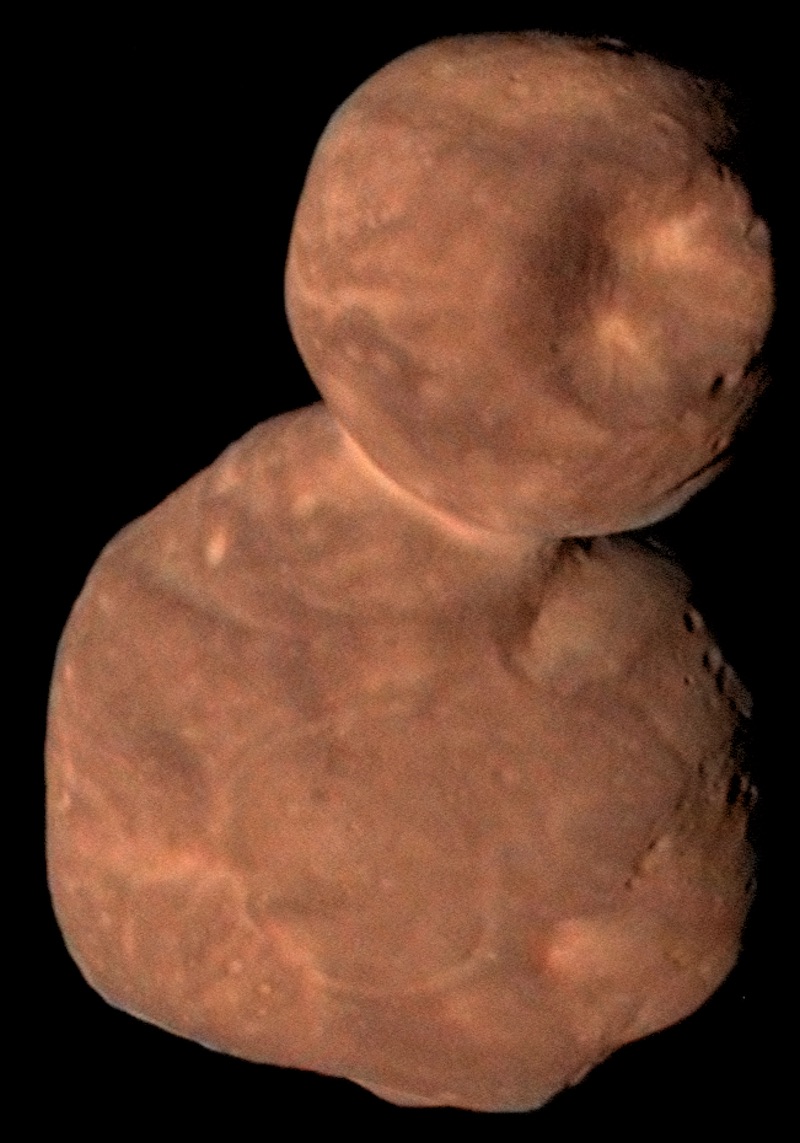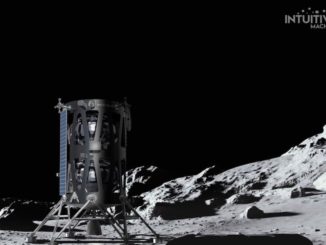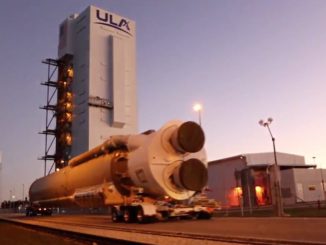
Data from the encounter of NASA’s New Horizons spacecraft with a frozen reddish snowman-shaped object a billion miles beyond Pluto last year suggest the building blocks of planets may have formed less violently than many scientists expected, officials said Thursday.
When New Horizons zipped past the distant world Jan. 1, 2019, the probe captured imagery that showed it was formed of two smooth connected lobes, both reddish in color with little sign of structural damage, cracks or other evidence of a violent collision.
The appearance led scientists to hypothesize that the two lobes likely formed near one another soon after the birth of the solar system 4.5 billion years ago, then merged together at a relatively slow relative velocity. Modeling of data gathered by New Horizons during last year’s New Year’s Day flyby has confirmed the low-speed merger hypothesis.
Named Arrokoth, the dual-lobe world measures about 22 miles (36 kilometers) long, 12 miles (20 kilometers) wide, and around 6 miles (10 kilometers) thick. Scientists have compared its shape to a partially flattened snowman.
Arrokoth orbits the sun once every 293 years, and is located some 4.1 billion miles (6.6 billion kilometers) from Earth in the Kuiper Belt, a ring of small, icy worlds beyond the orbit of Neptune.
The New Horizons published three papers in the journal Science this week discussing the latest findings.
“Arrokoth is the most distant, most primitive and most pristine object ever explored by spacecraft, so we knew it would have a unique story to tell,” said Alan Stern, principal investigator on the New Horizons mission from the Southwest Research Institute in Boulder, Colorado. “It’s teaching us how planetesimals formed, and we believe the result marks a significant advance in understanding overall planetesimal and planet formation.”
Scientists formally named the object Arrokoth in November after initially giving it the nickname Ultima Thule, a term in medieval mythology that meant “beyond the borders of the known world.” Although the name “Ultima Thule” is centuries old, Nazis used the term to refer to the mythological birthplace of the Aryan race, prompting protests from numerous members of the scientific community and beyond.
Arrokoth means “sky” in the Powhatan/Algonquian language. With consent from Powhatan Tribal elders and representatives, NASA’s New Horizons team proposed the new name to the International Astronomical Union, which oversees the formal naming of planetary objects and astronomical features.
Planetesimals are the building blocks of planets, many of which accreted into ever-larger clumps to create worlds like Earth. But some of the would-be planets stopped growing as other planet-forming materials coalesced elsewhere, leaving behind time capsules like Arrokoth ripe for research using modern spacecraft, instrumentation and computer modeling.
The results show the two pieces that formed Arrokoth formed close together, orbited one another, and then finally merged at a speed equivalent to a brisk walking pace.
That evidence suggests Arrokoth was created in a much less violent way than some scientists theorized.
“Just as fossils tell us how species evolved on Earth, planetesimals tell us how planets formed in space,” said William McKinnon, a New Horizons co-investigator from Washington University in St. Louis, and lead author of an Arrokoth formation paper in Science this week. “Arrokoth looks the way it does not because it formed through violent collisions, but in more of an intricate dance, in which its component objects slowly orbited each other before coming together.”
Scientists have come up with two major competing theories explaining planetesimal formation. One is called the cloud collapse model, and other is known as hierarchical accretion.
Data from the New Horizons mission supports the cloud collapse theory, indicating Arrokoth formed as solid particles in the primordial solar nebula gently collapsed onto one another under the tug of gravity. The competing theory of hierarchical accretion supposes that planetesimals collided with each other at high speed like billiard balls to accrete into larger bodies.
Visual evidence from the New Horizons flyby last year supports modeling suggesting the two lobes came together at slow speeds.
There is no sign of visible damage at the surface of Arrokoth, and both lobes appear the same color with the same mineral composition, suggesting they formed from the same type of material in the same region of the ancient solar system.
“Arrokoth has the physical features of a body that came together slowly, with ‘local’ materials in the solar nebula,” said Will Grundy, New Horizons composition theme team lead from Lowell Observatory in Flagstaff, Arizona, and the lead author of another Science paper. “An object like Arrokoth wouldn’t have formed, or look the way it does, in a more chaotic accretion environment.”
Scientists said the flattened shape of Arrokoth and close alignment of the equators and poles on each lobe also supports the conclusion that the two segments did not collide chaotically.
“All of the evidence we’ve found points to particle-cloud collapse models, and all but rule out hierarchical accretion for the formation mode of Arrokoth, and by inference, other planetesimals,” Stern said in a statement.
The new papers published in Science are follow-ups to a paper from May 2019 that laid out the New Horizons team’s initial conclusions from the Arrokoth flyby. The information released Thursday is based on 10 times as much data as the May 2019 report.
New Horizons flew by Arrokoth at a relative velocity of roughly 32,000 mph, or 9 miles per second (14 kilometers per second), obtaining a snapshot view the faraway world.
The fresh data downlinked New Horizons since last May also produced refined estimates of Arrokoth’s dimensions.
Scientists estimate Arrokoth’s larger lobe is about 12.8 miles (20.6 kilometers) by 12.4 miles (19.9 kilometers) by 5.8 miles (9.4 kilometers). The smaller lobe is roughly 9.6 miles (15.4 kilometers) by 8.6 miles (13.8 kilometers) by 6.1 miles (9.8 kilometers).
The updated dimensions give Arrokoth a volume about 30 percent larger than the previous estimate, the New Horizons team wrote in one of the Science papers this week.
Launched in 2006, the New Horizons spacecraft obtained the first up-close glimpse of Pluto and its moons in July 2015. Ground controllers steered the probe toward a second, more distant flyby target with leftover fuel after scientists discovered Arrokoth with the Hubble Space Telescope.
New Horizons is now in an extended mission, using its instruments to make long-range observations of other Kuiper Belt Objects and collect data on the radiation and dust environment more than 4 billion miles from the sun.
Scientists plan to use ground-based telescopes later this year to search for another target in the Kuiper Belt that New Horizons could reach for a close-up flyby in the coming years.
Email the author.
Follow Stephen Clark on Twitter: @StephenClark1.



